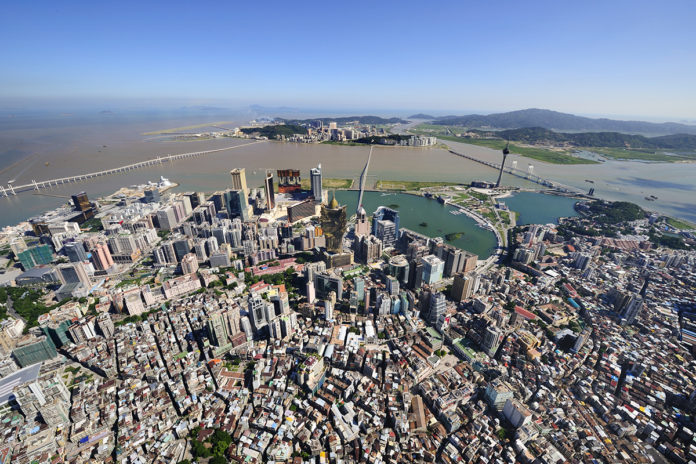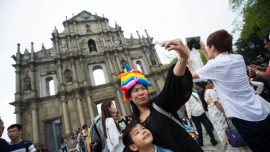The Shenzhen government is considering the construction of three new airports, creating fears of overcrowded airspace over the Pearl River Delta and the possibility of reduced traffic at Macau International Airport this week. The 1.4 trillion yuan (US$213.9 billion/MOP1.6 trillion) Eastward Shift Strategic Action Plan for 2016 to 2020, released last month, stated that the Chinese city bordering Hong Kong was planning to become a south China transport hub through the construction of a commercial airport near Huizhou, a hydroplane airport on Da Peng Peninsula and a helicopter airport. Overcrowded skies The announcement comes after the current Shenzhen airport, which handled 39.7 million passengers last year, announced a planned 11.2-billion-yuan third runway and fourth terminal, designed to meet demand until 2045. International flights to Shenzhen are also expected to double by 2020, according to Hong Kong newspaper South China Morning Post. Just recently, a planned third runway for Hong Kong International Airport (HKIA) caused concern. Previously CAM representatives told Business Daily the regional airspace could become too crowded and could be affected by regional air space issues. Simon Carrington, a Macau-based pilot told this newspaper that the “Shenzhen airspace is hemmed in between Hong Kong, Macau, Zhuhai, Guangzhou and military areas” and that he couldn’t see how Shenzhen could add significantly more flights without a “complete airspace redesign,” with the project being a very “complex and time-consuming project.” A different focus With these developments, the adding of more regional traffic by a possible new Shenzhen airport has spurred fears that Macau’s own airport expansion will be rendered useless and traffic will decrease if most international and local traffic is directed to that city. However some experts see the Shenzhen airport and Macau airport has having different target markets and not as direct competitors. “The Shenzhen and Macau airports have different recruitment areas, we focus on different sectors. You can see Shenzhen airport is facing competition from the Guangzhou and Hong Kong airports. They want to develop it as a hub and as a multi-function business, while in Macau we are only focused mainly on the tourist market. So we can say we have a different development target,” President of Macau Political Economy Research Association, and former Strategic Advisor at Macau International Airport, Samuel Tong, told Business Daily. Simon Carrington states that currently Shenzhen airport has “very little international traffic, and almost zero long-haul” with long-haul passengers currently passing through Hong Kong or Guangzhou, so any future Shenzhen airport would affect these airports since Macau is harder to get to from Shenzhen, and therefore “not really a competitor.” For Samuel Tong, Macau will need to find its niche market, especially in low cost carriers and general aviation for tourism passengers from Mainland China and Southeast Asia as “it’s very hard for Macau to attract the same airlines as Hong Kong airport, and airlines can only develop business on networking port-to-port. To develop in Macau they need to check the demand and we target tourists coming from Mainland China or South Asia, so they follow the direction of the demand.” For Tong, after the new bridge is completed, the Macau Airport will be more diversified, with cooperation with Hong Kong and Zhuhai airports crucial to provide a multi-functional business. “The three regions’ airports will be at the same position and we will compete with the Shenzhen airport and Guangzhou airport,” Tong told Business Daily. Betting on growth The Aviation Authority seems to have bet its chips on expanding the current Macau International Airport capacity and on the completion of the Light Rail Transit System and the Hong Kong-Zhuhai-Macau bridge, in order to increase the local airport traffic, stating that “with the enhancement of infrastructure development in the region (…) access from mainland cities in the region to Macau will be made a lot easier.” The local Aviation Authority believes there is an “opportunity to grasp” to make Macau a “spoke and hub centre in Asia” after convenient express link facilities are built. This would allow passengers from Mainland China to actually fly to their final destinations via Macau International Airport and vice versa, they told Business Daily. When questioned by this newspaper about the possible new Shenzhen airport, the Civil AAC claimed to “not have information about the opening of new airports in the Pearl River Delta.” A population problem However Jack Galati, CEO of Jet Asia Ltd, believes Macau’s airline business growth is limited by its own low population, since most airline companies look to base themselves in airports with great outbound resident populations. “The problem with the Macau International Airport is pretty simple, it does not have the local residents that can support this airport, with only 600,000 residents. For an airport to grow, you really need growth of population, and it hasn’t grown in Macau in 20 years, which is why the airport is still doing the same amount of traffic as at its peak in 2005,” Galati told Business Daily. In fact, the Jet Asia CEO states that transport of cargo has decreased “tremendously.” Tourism hasn’t worked that well Galati doesn’t believe focusing on tourism will do much to spur Macau’s airline business, since most airline companies look to base themselves in airports with great outbound resident populations. “Even Air Macau hasn’t grown, and it has been in existence for almost 20 years. It should’ve grown to at least 50 or 60 aircrafts. It hasn’t grown, not because they’re not doing the right job, but because you just don’t have passengers living in Macau wanting to travel to other destinations. Macau brings business in, not out, of Macau. You just don’t have it and the Hong Kong airport just offers more international flights on a daily basis, and that’s what passengers like.” Nevertheless Galati thinks the Macau airport expansion is positive, and if Macau’s population can grow to 1 million people, expansion should really be considered, however he doesn’t understand why it wasn’t already expanded in 2005 when the Master Plan was put together. Expansion too late and useless? The MSAR government has finished a Macau International Airport Master Plan, targeting at expanding maximum handling capacity to 15 million passengers per year, and aims to expand the facilities in three short, medium and long-term stages, says Euphemia Lam, Senior Officer at the Aviation Authority. The CAM-Macau International Airport Company Ltd. has also started expanding the north passenger terminal, aiming to increase its total area from 45,000 to 59,000 square meters by mid-2017. The project aims to increase usage of passenger areas, the commercial areas and the operation areas of the airport, and to connect the passenger terminal with the projected Light Rail Transit System. In terms of passenger traffic, Macau International Airport currently ranks 37th on the list of China’s busiest airports, with an expansion to 15 million passengers likely to raise that position to 20th, according to CAAC statistics from 2015. Zhuhai Jinwan Airport, which only caters to China’s domestic flights, is placed 41st with 4.7 million passengers, while Hong Kong Airport placed second with 68 million passengers, only surpassed by Beijing Airport. “I worked on the Master Plan 15 years ago and we had a pretty good plan to get more parking spaces in between the taxi ways and so forth. We anticipated many years ago that this airport would have at least doubled its traffic by now, but it has not,” Galati stated. From the CEO’s own experience, the growth has not occurred because the population has not grown, and Hong Kong airport has become to efficient, tripling its traffic since 2000, to 600 flights a day. “Because they are efficient and have the population and airlines wanting to fly there,” Galati told Business Daily. Expand, and quickly Some experts believe the problem lies in the pace at which the current expansion and bridge are being constructed. Problems with the US$10.6 billion planned bridge construction have delayed its opening to 2017, while the LRT Taipa section, with 11 stations covering the Cotai area and Lotus Border checkpoint, has had its operational date pushed back from the originally scheduled 2016 to 2019. “I think it is critical for the airport to plan ahead and expand as fast as possible. The airport already operates at its 6 million passengers per year designed capacity, but is growing at 10 per cent per year. Statistically speaking, each new mega-resort adds over 200,000 passenger movements per year,” Simon Carrington told Business Daily. The experienced Macau-based pilot believes the growth trend will continue as Wynn Palace and the Parisian open this year, with MGM and SJM’s new properties opening next year. “Historically the mega-resorts have not marketed themselves (or Macau), since the bulk of profits came from a limited number of VIP gamblers organised by mainland junkets. With the change in the mainland’s political/economic climate, these resorts have now begun proper marketing campaigns,” Simon Carrington told Business Daily. The Hong Kong connection Carrington also stated the Macau Airport is at a certain level ‘under-utilised’ by its own volition, due to influence by Hong Kong airport. “From 11am until 1pm, and again from 6pm to 8pm, there are two rush hour periods, and the parking stands, air bridges, and take-off slots are all busy,” the pilot stated, adding the Hong Kong air traffic control only permits one departure every five minutes out of Macau, compared to one every 80-120 seconds out of Hong Kong, creating an “artificial constriction.” According to Carrington, for the rest of the day the Macau Airport doesn’t operate “anywhere near capacity” with a “24-hour shortage” in parking. The pilot also added there is massive demand for corporate jet parking in Macau, with Hong Kong airport having run out of space, and a real shortage of affordable space, representing a big opportunity for Macau Airport to quickly expand its current 20-year-old apron. “The real question is what the impact of the Hong Kong bridge will be? Personally I believe that smaller, low-margin traffic will be shunted off from Hong Kong to Macau, and I believe that long-haul airlines will start flying to Macau pending getting a slot in Hong Kong. We have already seen the start of that trend with regular charter flights from Macau to Moscow,” the pilot told Business Daily. “Clearly Macau has nothing like the capacity and infrastructure, but I foresee a rapid acceleration in Macau traffic post 2020 if the airport has the infrastructure in place.” Zhuhai sword dangling For Carrington the biggest threat to Macau’s airline business will be if the neighbouring Zhuhai airport decides to open up to international flights, since Macau acts as the international airport for Zhuhai. But Air Macau has done very little marketing in the area. However Samuel Tong believes the Zhuhai government is only planning to “develop the airport as a better chain for all aviation business, no matter if its for transportation, repairs, manufacturing or professional training. They want to become more competitive, and less focused on the transportation business.”
—
























